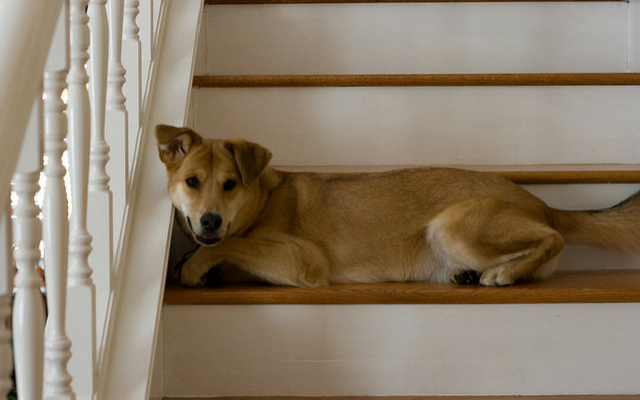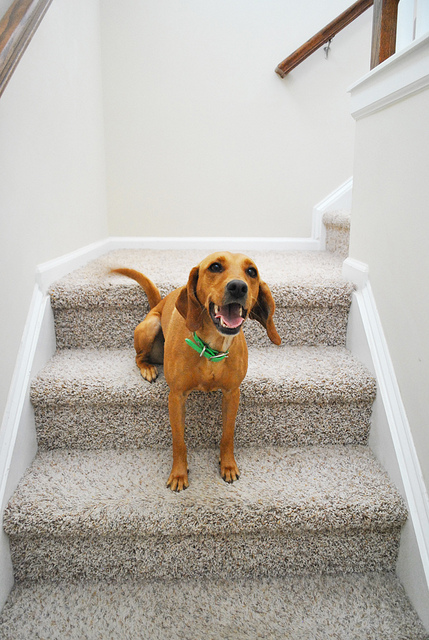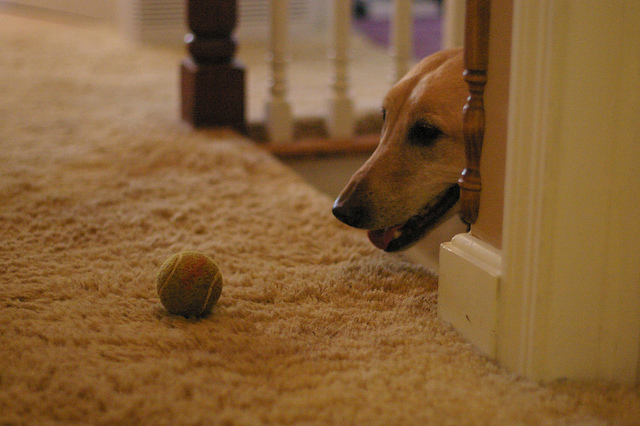The fear of going up and down stairs can affect puppies, rescues, adults, and senior dogs, and it poses specific challenges for both the dog and their owner. Regardless of the dog’s age or size, there’s always a reason for the trembling, crying, and backing up that happens when faced with a threatening staircase.
Sometimes it’s only a particular staircase that puts the dog on edge, and in other cases, every raised platform or increase in elevation triggers a fearful reaction. If this sounds like your pup, the first step in helping them overcome their fear is understanding what’s causing it. Here are a few common possibilities.

#1 – Lack of Exposure
For puppies, a fear of stairs usually comes from the simple fact they’ve never seen them before. From the moment they’re born, puppies are exposed to a whirlwind of new experiences. Everything from the carpet they stand on to the neighbor’s cat is potentially new and scary. The first staircase a puppy sees will look like a big, intimidating obstacle. For the most timid of the litter, the sheer newness could pose a serious threat.
Puppies aren’t the only ones that develop fears based on lack of exposure. If you have an older dog that’s lived its entire life in a single-story home, there’s a good chance they’ve never needed to go up or down stairs before. They missed that vital lesson during puppy socialization, and now that they’re older, coming across something new is especially unnerving.
#2 – Traumatic Experience
Dogs learn through past experiences, and the type of exposure they receive to certain stimuli is as important as being exposed in general. If something bad happened to them on or near a flight stairs, it’s natural for them to develop a phobia. Whether they fell or were pushed down a staircase, they’re not likely to forget what happened. Even if they weren’t physically injured, being especially startled by something on the stairs could have a lasting negative impact. They’ll be reminded of that one scary experience every time they encounter a flight of stairs.

#3 – Learned Behavior
It’s usually an accident, but dog owners sometimes teach their pets to be afraid of stairs. If the dog isn’t allowed on the second floor during the day, for example, owners will use different tactics to discourage them from using the stairs. Baby gates are seemingly harmless, but any kind of negative attachment to the stairs is enough to convince a timid dog all stairs are bad news regardless of circumstance. Punishing a dog when they attempt to go up (or down) the stairs will teach them to stay away.
#4 – Medical Condition
If none of these other scenarios seem to make sense for your dog, it could be a medical condition keeping them on the ground floor. Arthritis, hip dysplasia, or a recent injury could make climbing stairs especially painful. If that’s the case, they’re not afraid of stairs, they’re avoiding pain. Senior dogs with no previous issues with stairs gradually exhibit avoidance behaviors for this reason, and a congenital abnormality in a young puppy can be confused for a phobia. Talk to your vet to rule out painful possibilities before moving forward with training.
Related: 10 Best Dog Doors
Overcoming the Fear
A dog that’s afraid of stairs will demonstrate “avoidance behaviors” that should make it obvious they’d rather bypass the steps than face their uncertain heights. They might walk confidently toward the stairs only to turn tail and go the other way. Whining, puting their tail between their legs, and acting generally uncomfortable are other signs they’re not confident with the situation.
For small dogs, there’s always the temptation to pick them up and carry them up or down the stairs. This will save you time, but it’s a temporary solution. It teaches the dog they get what they want by whining or acting fearful, and it doesn’t help them overcome their fear. It’s also a bad idea to drag the dog by the collar up the stairs. This behavior can cause mistrust between dog and owner, and the dog could act out in a defensive form of aggression.
Try these techniques instead.

Counter Conditioning
A dog that’s afraid of stairs is relating the staircase to something negative. To reverse their feelings of unease, try something dog trainers call “counter conditioning.” Animal Humane Society says,
“Counter conditioning means training an animal to display a behavior that is different than his current reaction to a stimulus.”
In the case of scary stairs, the dog’s current reaction is fear. Counter conditioning and positive reinforcement works by replacing fear with a positive reaction, like happiness and excitement.
Try using a favorite toy or an especially high value treat. Start by standing near the stairs and encourage pup to approach. When they do, give them their reward and shower them with praise. Make them feel like they’re the best dog in the world, and they’ll forget about the scary association to the stairs.
Desensitization
Counter conditioning works best when paired with desensitization. This is the gradual exposure to something that starts with low intensity and works it’s way up to full exposure. Rewarding the dog for going near the stairs is stage one. Next is encouraging the dog to climb the first step.
Use the same positive reinforcement you did before, but this time, stand on the first step and encourage your dog to meet you there. Tempt them with their special reward, and make a big deal about their accomplishment when it happens. Keep up this strategy for one step at a time.
An effective way to accomplish gradual desensitization is by using dinner time to your dog’s advantage. Most dogs look forward to when their dish is full of food, and there’s a good chance their love of dinner will outweigh their fear of stairs. On the first day, place their food bowl on the floor next to the stairs. If they eat without hesitation, move the bowl to the first step the next night. If that goes well, go to the second step the following night. Keep up the pattern until your dog is confidently climbing the stairs to reach their dinner. You may have to stay on one step for a few days in a row before they’re ready to move on.
Patience
It will take more than one lesson for a dog to overcome a fear of stairs. Mild cases might require a few days of positive reinforcement training, and more fearful dogs could take several weeks. Petcha says,
“It’s important not to rush his progress on stairs because he may panic and his fear of the stairs could become very long-lasting. Confidence builds at its own rate, which is different for each dog.”
No matter how frustrating or inconvenient, don’t rush the process. Remember to stay calm and look for small improvements instead of expecting big results.
Featured image via Flickr/Jesse Newland
(h/t: Pet Helpful, Animal Humane Society, Petcha )
 Toledo, United States.
Toledo, United States.
